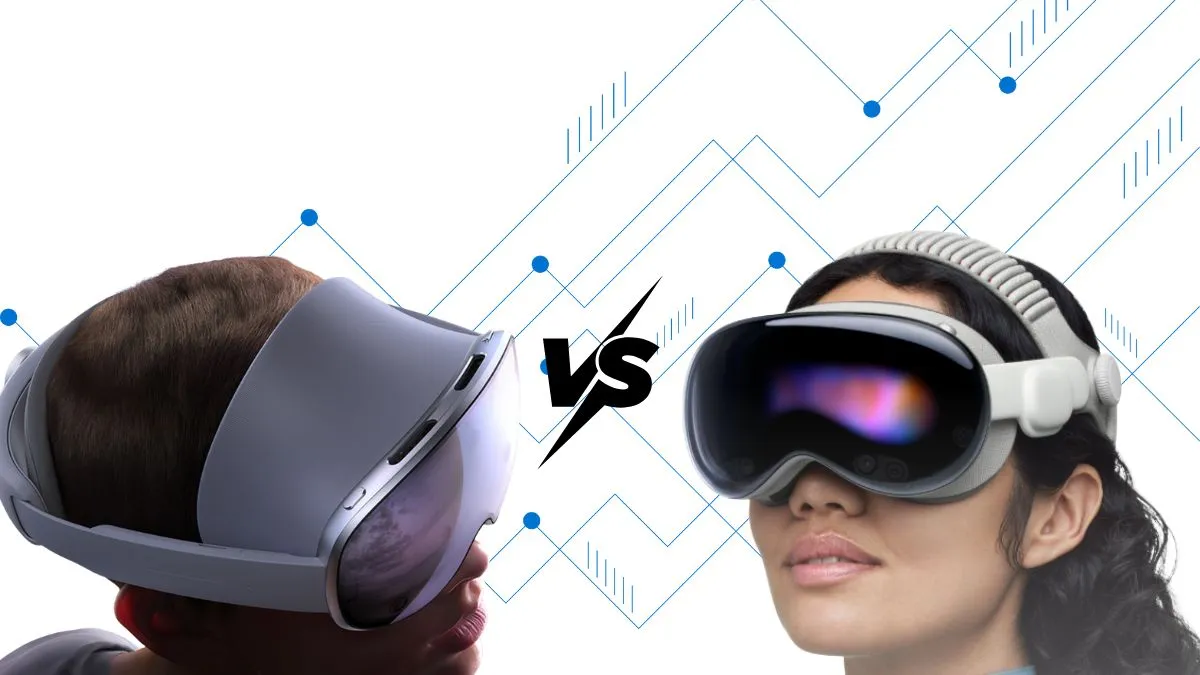- By Prateek Levi
- Thu, 23 Oct 2025 01:40 PM (IST)
- Source:JND
Apple Vision Pro Vs Samsung Galaxy XR: When it comes to virtual tech both Apple and Samsung have unveiled their top of the line products. Although this VR space is not new and Gaming console makers like Sony have been doing this for a while now, these two products go beyong just the scope of gaming. Samsung has set its foot in the high-end Extended Reality( XR) headset market, and has dropped its Galaxy XR headset that now stands in direct competition with Apple's Vision Pro.
Both these products focus on streamlining users daily interaction with their personal tech and bring immersive virtual and mixed reality to it. Although the core principle remains the same both products come out with their own separate architecture and approaches when it comes to design, pricing, and technology. Lets take a look at both the devices carefully, to see which one's the best fit for you.
Operating Systems and Ecosystem
The Galaxy XR runs on Android XR, built in partnership with Google, and tightly integrates Gemini AI. Gemini doesn’t just respond—it understands what you’re looking at, offering contextual help or completing actions such as booking a flight or explaining a scene. That AI-centric approach makes Samsung’s device appealing for productivity and creative tasks within the vast Android app world.
Apple’s Vision Pro runs visionOS, designed to sync effortlessly with Macs, iPhones, and AirPods. Siri and Apple Intelligence anchor the experience, emphasizing spatial computing and seamless transitions between entertainment and work.
Design and Comfort
Weighing in at around 545 grams, the Galaxy XR feels noticeably lighter than Apple’s Vision Pro models, which range between 600 and 750 grams depending on version. Samsung puts comfort front and center, using a plush head cushion and a dial-based strap for fine adjustments. Apple, in contrast, favors a breathable dual-knit band to keep pressure balanced. Both brands clearly aim for comfort that can last through hours of use.
Battery Life
Samsung’s headset runs for about two hours of everyday use or two and a half hours of video playback on its external 302-gram battery pack. Apple’s Vision Pro lasts slightly longer—around two and a half hours of general use and up to three hours for video. Both can stay powered while plugged in, so users don’t need to take breaks when the battery dips.
Software and Applications
The Galaxy XR benefits from the full weight of Android and Google’s ecosystem. It runs familiar apps like YouTube, Google Maps in immersive 3D, and Google Photos for depth-based image viewing, while Adobe’s Project Pulsar handles creative editing. Google’s Gemini AI assistant adds a layer of interactivity that shines in scenarios like gaming, sports streaming, or multitasking.
Apple’s approach stays tightly bound to its ecosystem—Vision Pro leans on its own suite of native apps, backed by spatial audio, ray-traced rendering, and precision gesture tracking. It’s a more enclosed but highly polished experience built for creative and professional work.
Display and Visuals
Samsung uses twin 4K Micro-OLED displays with a combined pixel count north of 29 million and pixel density around 4,023 PPI—crisper than the Vision Pro’s 23 million pixels and 3,386 PPI. Apple, however, edges ahead in fluidity with a 120Hz refresh rate compared to Samsung’s 90Hz. Both displays deliver top-tier brightness, clarity, and color fidelity.
Tracking and Interaction
Both headsets rely on inside-out tracking supported by multiple cameras, along with eye tracking and iris scanning for secure sign-ins. Samsung includes facial tracking that brings animated avatars to life, gradually evolving from playful to realistic renderings. Apple’s “Personas,” meanwhile, are already detailed, photo-realistic digital versions used in video calls. Input is handled similarly on both through a mix of eye movement, hand gestures, and voice control, keeping the experience intuitive and immersive.
Price and Market Position
Samsung takes a more accessible route with the Galaxy XR, setting its price at $1,799—roughly half of Apple’s $3,499 Vision Pro. The difference doesn’t make either device cheap, but it does open Samsung’s headset to a wider group of early adopters rather than limiting it to Apple’s high-end niche.
ALSO READ: Xbox President Teases Next Console As A 'Very Premium' Leap Forward
Shared Highlights
-Dual high-resolution Micro-OLED displays
-Inside-out tracking with iris and eye detection
-Gesture, eye, and voice-based controls
-External batteries offering a few hours of use
-Integrated AI assistants: Gemini vs. Siri and Apple Intelligence

